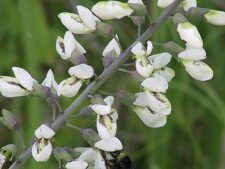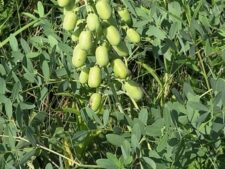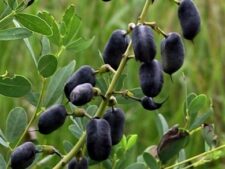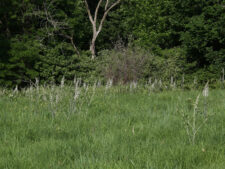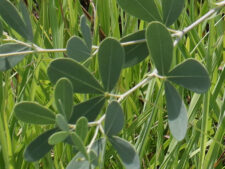
WHITE WILD INDIGO
Baptisia alba var. macrophylla
BEAN FAMILY (Fabaceae)
 Identification
Identification
- Flowering time - May, June
- Common in some, not all, prairie restorations at Neale Woods
- Erect, white pea-like flower clusters from 1-2 feet long
- Beaked green seed pods turning black at maturity
- See comments for comparison with Plains Wild Indigo (Baptisia bracteata)
This native perennial, usually with a single erect flowering stem, grows from 2-6 feet tall (A). The ascending branches have alternate compound leaves divided into 3 nearly oval leaflets (F). Long, erect, smooth stems bear individually stalked, white, pea-like flowers in clusters (racemes) up to 2 feet long (A,B,E). The fruit is a smooth, beaked pod 1-2 inches long which turns black on ripening (C,D).
Found in moist to dry prairie sites. At Neale Woods it is common in some, but not all, prairie restorations. There was an especially good showing in the Knull Prairie restoration in 2022 (photo E). Flowering occurs in June and July.
White flowers and smooth, hairless, erect stems separate White Wild Indigo from a closely related species, Plains Wild Indigo (Baptisia bracteata var. leucophaea) which is shorter and has cream-colored flowers on nodding, hairy stems. This plant is quite rare at Neale Woods where only a few occur near the old observatory in Knull Prairie.
Other common names include False White Indigo, Rattlepod and Atlantic Wild Indigo.
Weevils often eat the seeds in the pods before they mature.
The content of NatureSearch is provided by dedicated volunteer Naturalists of Fontenelle Forest who strive to provide the most accurate information available. Contributors of the images retain their copyrights. The point of contact for this page is: Neal Ratzlaff.

